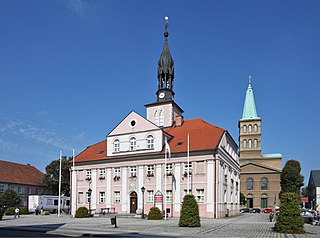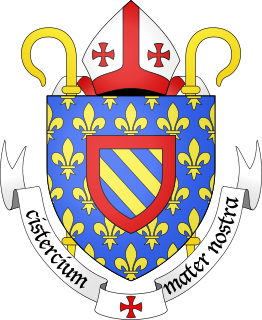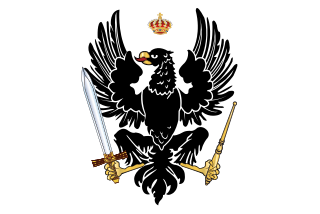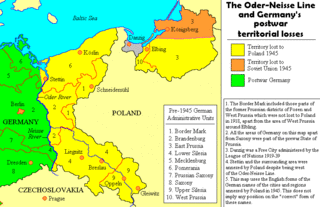
Skwierzyna is a town of 10,339 inhabitants (2005) in Lubusz Voivodeship in western Poland, the administrative seat of the Gmina Skwierzyna. It is located at the confluence of the Obra and Warta rivers, about 18 km (11 mi) north of Międzyrzecz and 23 km (14 mi) south-east of the regional capital Gorzów Wielkopolski. The town is situated in a particularly green part of Poland. Extensive forests and numerous lakes can be found in the vicinity.

Głębokie is a village in the administrative district of Gmina Międzyrzecz, within Międzyrzecz County, Lubusz Voivodeship, in western Poland. It lies approximately 6 kilometres (4 mi) north-west of Międzyrzecz, 34 km (21 mi) south-east of Gorzów Wielkopolski, and 61 km (38 mi) north of Zielona Góra.

Kalsko is a village in the administrative district of Gmina Międzyrzecz, within Międzyrzecz County, Lubusz Voivodeship, in western Poland. It lies approximately 8 kilometres (5 mi) north of Międzyrzecz, 36 km (22 mi) south-east of Gorzów Wielkopolski, and 64 km (40 mi) north of Zielona Góra.

Kęszyca is a village in the administrative district of Gmina Międzyrzecz, within Międzyrzecz County, Lubusz Voivodeship, in western Poland. It lies approximately 7 kilometres (4 mi) south-west of Międzyrzecz, 40 km (25 mi) south-east of Gorzów Wielkopolski, and 53 km (33 mi) north of Zielona Góra.

Kursko is a village in the administrative district of Gmina Międzyrzecz, within Międzyrzecz County, Lubusz Voivodeship, in western Poland. It lies approximately 11 kilometres (7 mi) west of Międzyrzecz, 36 km (22 mi) south of Gorzów Wielkopolski, and 55 km (34 mi) north of Zielona Góra.

Rojewo is a village in the administrative district of Gmina Międzyrzecz, within Międzyrzecz County, Lubusz Voivodeship, in western Poland. It lies approximately 9 kilometres (6 mi) north of Międzyrzecz, 32 km (20 mi) south-east of Gorzów Wielkopolski, and 65 km (40 mi) north of Zielona Góra.

Święty Wojciech is a village in the administrative district of Gmina Międzyrzecz, within Międzyrzecz County, Lubusz Voivodeship, in western Poland. It lies approximately 4 kilometres (2 mi) south-west of Międzyrzecz, 39 km (24 mi) south-east of Gorzów Wielkopolski, and 55 km (34 mi) north of Zielona Góra.

Wysoka is a village in the administrative district of Gmina Międzyrzecz, within Międzyrzecz County, Lubusz Voivodeship, in western Poland. It lies approximately 14 kilometres (9 mi) south-west of Międzyrzecz, 43 km (27 mi) south of Gorzów Wielkopolski, and 48 km (30 mi) north of Zielona Góra.

Zamostowo is a village in the administrative district of Gmina Międzyrzecz, within Międzyrzecz County, Lubusz Voivodeship, in western Poland. It lies approximately 10 kilometres (6 mi) west of Międzyrzecz, 34 km (21 mi) south-east of Gorzów Wielkopolski, and 58 km (36 mi) north of Zielona Góra.

Bledzew is a village in Międzyrzecz County, Lubusz Voivodeship, in western Poland. It is the seat of the gmina called Gmina Bledzew.

Goruńsko is a village in the administrative district of Gmina Bledzew, within Międzyrzecz County, Lubusz Voivodeship, in western Poland. It lies approximately 4 kilometres (2 mi) south of Bledzew, 14 km (9 mi) west of Międzyrzecz, 30 km (19 mi) south of Gorzów Wielkopolski, and 61 km (38 mi) north of Zielona Góra.

Nowa Wieś is a village in the administrative district of Gmina Bledzew, within Międzyrzecz County, Lubusz Voivodeship, in western Poland. It lies approximately 6 kilometres (4 mi) south-west of Bledzew, 16 km (10 mi) west of Międzyrzecz, 30 km (19 mi) south of Gorzów Wielkopolski, and 60 km (37 mi) north of Zielona Góra.

Osiecko is a village in the administrative district of Gmina Bledzew, within Międzyrzecz County, Lubusz Voivodeship, in western Poland. It lies approximately 8 kilometres (5 mi) west of Bledzew, 23 km (14 mi) west of Międzyrzecz, 25 km (16 mi) south of Gorzów Wielkopolski, and 66 km (41 mi) north of Zielona Góra.

Pniewo is a village in the administrative district of Gmina Bledzew, within Międzyrzecz County, Lubusz Voivodeship, in western Poland. It lies approximately 11 kilometres (7 mi) west of Bledzew, 25 km (16 mi) west of Międzyrzecz, and 23 km (14 mi) south of Gorzów Wielkopolski.

Popowo is a village in the administrative district of Gmina Bledzew, within Międzyrzecz County, Lubusz Voivodeship, in western Poland. It lies approximately 7 kilometres (4 mi) east of Bledzew, 10 km (6 mi) north-west of Międzyrzecz, 30 km (19 mi) south-east of Gorzów Wielkopolski, and 65 km (40 mi) north of Zielona Góra.

Sokola Dąbrowa is a village in the administrative district of Gmina Bledzew, within Międzyrzecz County, Lubusz Voivodeship, in western Poland.

Strużyny is a settlement in the administrative district of Gmina Bledzew, within Międzyrzecz County, Lubusz Voivodeship, in western Poland. It lies approximately 3 kilometres (2 mi) south-west of Bledzew, 17 km (11 mi) west of Międzyrzecz, 28 km (17 mi) south of Gorzów Wielkopolski, and 63 km (39 mi) north of Zielona Góra.

Panowice is a village in the administrative district of Gmina Trzciel, within Międzyrzecz County, Lubusz Voivodeship, in western Poland. It lies approximately 11 kilometres (7 mi) west of Trzciel, 14 km (9 mi) south-east of Międzyrzecz, 50 km (31 mi) north of Zielona Góra, and 53 km (33 mi) south-east of Gorzów Wielkopolski.

Siercz is a village in the administrative district of Gmina Trzciel, within Międzyrzecz County, Lubusz Voivodeship, in western Poland. It lies approximately 11 kilometres (7 mi) north-west of Trzciel, 12 km (7 mi) east of Międzyrzecz, 49 km (30 mi) south-east of Gorzów Wielkopolski, and 56 km (35 mi) north of Zielona Góra.























